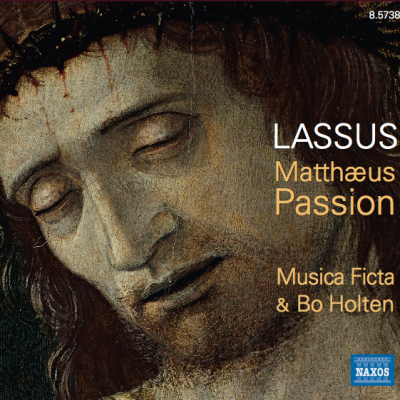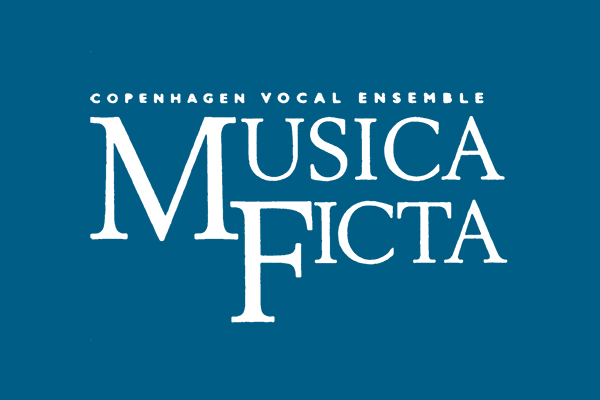
St. Mattews Passion By orlandus Lassus
Naxos 8.573826
Musica Ficta
Medvirkende
Ann-Christin W. Ingels, Louise Odgaard – sopraner
Eva Wöllinger-Bengtson – alter
Tobias Aabye Dam, Josef Hamber – tenorer
Lauritz Jakob Thomsen, Rasmus Kure Thomsen og Torsten Nielsen – basser
Bo Holten, dirigent
Viggo Mangor, producer og teknik
Christian Tobiassen, manager
Indspillet i Esajas Kirke, april 2015
“…it’s worth hearing Lassus’s 1575 setting. The singing is clean and pleasing.” BBC Music Magazine
“Matthæus-passionen” er i den grad blevet et ikon i alle musikelskeres bevidsthed at tankerne strax går til Bachs rystende mesterværk. Men det var jo ikke Bach der fandt på at sætte påske-evangeliet i musik. Man skal ikke glemme at fremførelser, musikalsk og teatralsk, af Jesu lidelse og død går tilbage til de allertidligste kristne menigheder i romerigets dage. Påskens budskab har så at sige altid været iklædt en gennemspilning af hele lidelsesforløbet i de stille dage frem til opstandelsen på påskedag. I de tidlige århundreder blev passionerne sunget eenstemmigt, hvordan ved vi næppe, men i århundredernes forløb opstod den kirkelige eenstemmige gregorianske sang, som givetvis har været meget forskellig over hele den kristne verden. Dog lader det til at man ofte har haft en særlig evangelist-rolle og en Jesus-rolle, medens mindre “partier” som Pilatus og Judas har været sunget af andre. Omkring 1500 begyndte man at komponere hele flerstemmige passioner, men mange tonesætninger holdt fast ved at have evangelist-fortællingen samt Jesu replik – ker som enstemmig sang, medens resten blev udsat flerstemmigt. Til denne katego
‘The Matthew Passion’ has, through the centuries become an icon in the consciousness of all music lovers, so much so that one immediately think of Bach’s towering masterpiece. But, of course, it was not Bach’s idea to set Matthew to music: performances of the Christian Easter rites has taken place since earliest Christendom, in varying guises through the centuries, as a way of celebrating the Passion story at Easter.
In earlier times, the Passion was either recited or sung monophonically. How they did it and what it sounded like we know very little about, but through the centuries the classical Gregorian plainsong developed, possibly quite differently all over Christendom. It seems though that the concept of someone singing the role of Christ and another singing as Evangelist, and Pilate and Judas as well as various smaller parts taken by different singers was developing.
Around 1500 polyphonic Passions were composed where the entire gospel was sung in four- or five-part harmony, but other settings retained having a large plainsong solo-part for the Evangelist as well as for Jesus while having other roles sung polyphonically. In protestant areas, the Lutheran chorales were inserted in the Passion story.
Lassus’ Matthew Passion was composed in the Roman Catholic tradition at the Munich court. He set all four gospels in a rather austere style, the Matthew Passion being the most elaborate – and that is why we chose it for our performances. Unfortunately, it is unclear which kind of chant was used in this tradition, but we have chosen a Roman passion chant that Lassus might have been familiar with having served for several years as chief of music at the Lateran in Rome.
During the Renaissance, it was customary to insert polyphonic motets into religious services with texts that fitted the occasion. We do not know if this was also the case during Easter celebrations, but I have tried to find fitting pieces among Lassus’ rich treasure of motets (and even a spiritual madrigal!) to illuminate certain key moments in the otherwise austere Passion story.
I hesitate to call this a ‘reconstruction’ of how Lassus’ Passion may have sounded in 1575 Munich – which, in
3
any case, we know very little about – but I think it might be a way of making Lassus’ wonderful music accessible to a modern audience, making its natural and reticent telling of the story easy and appealing to follow. Several years of performing it also confirms my belief in conveying its deeply felt contents successfully in this way.
Orlandus Lassus (1532–1594) was the most versatile and arguably also the greatest composer of the 16th century. He was justly famed and celebrated in his own time, and a much-treasured teacher for the generation of composers who would implement the radical paradigm shift into the Baroque period! Active in all genres, he would also excel in acting comic roles and putting on big musical events – having under him, in Munich, an ensemble of singers and instrumentalists of almost 100 people. Mastering Flemish, French, Italian, Spanish, German and Latin, he would correspond multi-linguistically and indeed humorously.
About four years before his death he suffered a serious stroke, after which he became, according to the testimony of his wife, melancholy and obsessed with thoughts of death – a state of mind reflected in the last two collections he prepared for publication: the six-voice Cantiones sacrae, published at Graz in 1594, and the Lagrime de San Pietro, published posthumously the following year.
The fact that nowadays, alas, he is not nearly as well known as contemporaries such as Palestrina, Victoria and William Byrd, might be explained by his name being so different in various languages: In his childhood he was the brilliant boy soprano Orlande de Latre in Mons and Antwerp; in Italy in his youth he was Orlando di Lasso; visiting the French king (who adored him) he was called Roland de Lassus; in Latin Orlandus Lassus; and in Germany he was called a variety of these, married a German woman and had nine sons and seven daughters by her, all of them having German names – and some of them also becoming composers, collecting and editing their father’s enormous oeuvre.
Bo Holten
Bo Holten









